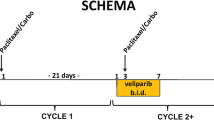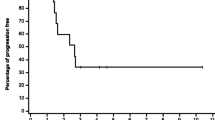Abstract
Purpose: In recognition of the variety of available chemotherapeutic modulating agents and their potential to enhance the efficacy of platinum-based therapy, we embarked upon a phase I study to investigate the feasibility of combining fixed doses of carboplatinum (CBDCA) and etoposide (VP-16) with 24-h concurrent infusions of dipyridamole (DP), prochlorperazine (PCZ) and cyclosporine A (CSA) administered in escalating doses. Methods: Patients received intravenous VP-16 (200 mg/m2) and CBDCA (300 mg/m2), each over 30 min, starting at hour 6 of the modulator infusions. Resistance modulators were escalated sequentially to determine their respective maximally tolerated doses (MTDs). The pharmacokinetics (PK) of VP-16, CBDCA, and the three drug resistance (DR) modifiers were studied in eight patients. Results: A total of 59 patients were entered on study. The MTD was established at DP 5 mg/kg per day, PCZ 24 mg/h, and CSA 9.5 mg/kg per day. Dose-limiting toxicities included hypotension and severe sedation, presumably related to PCZ. No objective responses were seen. PK studies were performed when PCZ and DP doses were 24 mg/h and 3.3 mg/kg, and the CSA dose was either 8.5 mg/kg (five patients) or 9.5 mg/kg (three patients). The median clearance of VP-16 was 0.96 l/h per m2 (range 0.8–1.5 l/h per m2), which is lower than for VP-16 alone and similar to previously reported effects of CSA on VP-16 elimination. The median measured CBDCA AUC was 3.0 mg/ml · min (range 2.4–4.8 mg/ml · min). CBDCA AUC predicted by the Calvert formula using measured creatinine clearance underestimated the actual AUC in seven of the eight patients, in one case by as much as twofold. The median end of infusion PCZ and total DP plasma concentrations were 1.2 μM (range 0.5–2.2 μM) and 4.4 μM (range 1.3–5.9 μM), respectively, consistent with in vitro resistance modulatory levels. However, free DP was only 0.02 μM (range 0.004–0.04 μM). The median CSA level at 24 h of 1450 μg/l (range 1075–1640 μg/l) is in agreement with concentrations required for partial DR reversal in vitro, although it is much lower than levels achieved in our previous phase I study of CBDCA + CSA alone using similar doses of CSA. The CSA dose on the current trial was escalated beyond the MTD for the previous phase I study, suggesting that there may be an interaction between CSA and one of the other modulators. Conclusion: These results demonstrate that in vitro DR- reversing levels of two of the three agents used in this study can be achieved in vivo, and that this combination of DR modulators has significant effects on the pharmacokinetics of VP-16.
Similar content being viewed by others
Author information
Authors and Affiliations
Additional information
Received: 2 September 1999 / Accepted: 25 April 2000
Rights and permissions
About this article
Cite this article
Raschko, J., Synold, T., Chow, W. et al. A phase I study of carboplatin and etoposide administered in conjunction with dipyridamole, prochlorperazine and cyclosporine A. Cancer Chemother Pharmacol 46, 403–410 (2000). https://doi.org/10.1007/s002800000142
Issue Date:
DOI: https://doi.org/10.1007/s002800000142




